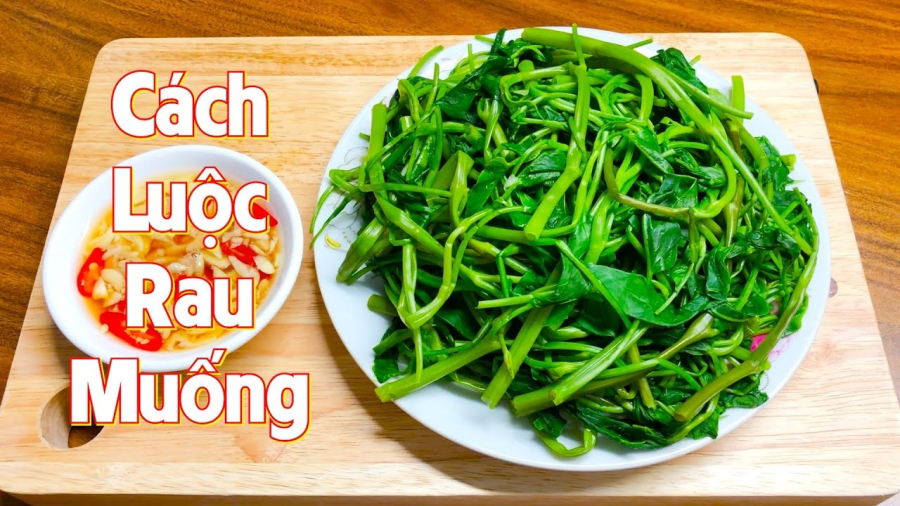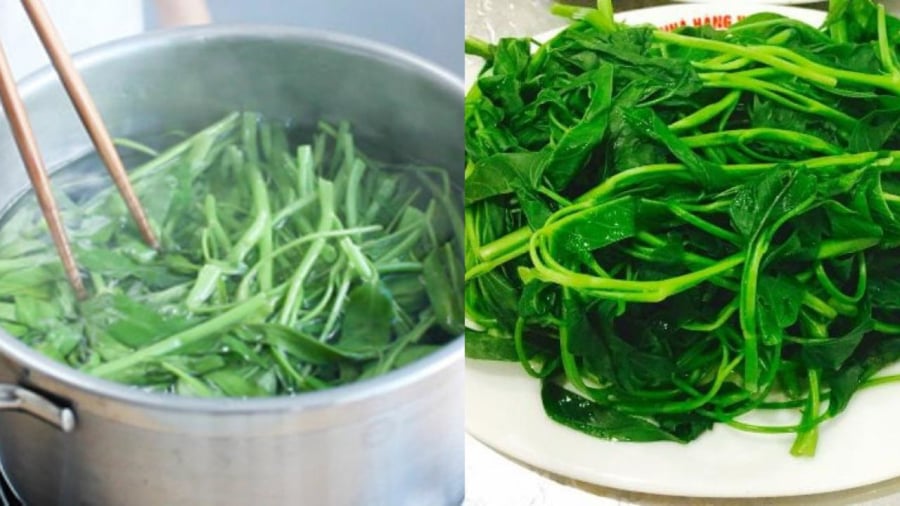How to Boil Water Spinach: Tips for a Vibrant, Crisp Dish
Boiling water spinach may seem like a simple task, but to maintain its vibrant green color, crispiness, and flavor while preventing it from turning dark requires some tricks.

A Simple Guide to Boiling Crisp, Green Water Spinach
Add Salt to the Boiling Water
Salt increases the temperature of the water, reducing the boiling time. This ensures that the water spinach cooks evenly, remains crisp and vibrant, and prevents it from becoming mushy or brown due to overcooking. Additionally, adding salt enhances the flavor of the boiled spinach.
Use approximately 1/2 to 1 teaspoon of salt for every pot of water, depending on the quantity.
Add salt to the water at the beginning and wait for it to boil before adding the water spinach. When the spinach is cooked, remove it from the boiling water and immediately plunge it into a bowl of ice water to preserve its green color and crispness.
Add Vinegar/Lemon Juice to the Boiling Water
Adding vinegar or lemon juice to the boiling water helps maintain the vibrant green color of the water spinach. A small amount of vinegar/lemon juice preserves the spinach’s natural color without altering its taste.
Simply add approximately 2 teaspoons of lemon juice or vinegar to the boiling water and bring it to a boil. Once boiling, add the water spinach and remove it when cooked.
Submerge the Spinach in Water
To ensure that the water spinach remains crisp and green, it should be completely submerged in water. Cook the spinach until it reaches the desired level of doneness, avoiding undercooking (which can result in a dark color) or overcooking (which can turn the spinach yellow).
Immerse the Spinach in Cold Water After Boiling
Prepare a bowl of cold water with ice (you can add a few lemon peels for added aroma) and immediately transfer the boiled spinach to the cold water. Keep it submerged until the water loses its chill, then remove the spinach and drain any excess water.
These tips help preserve the vibrant green color, crispiness, and flavor of boiled water spinach.
The simplest method is to use plenty of water and a small amount of spinach. This allows the water to boil quickly and cook the spinach rapidly. Using too much spinach can slow down the boiling process, increasing the cooking time and potentially causing the spinach to discolor. The discoloration occurs when the water takes too long to boil, causing the polyphenols in the spinach to oxidize and turn red, making it appear unappetizing.
Method 4: Before adding the spinach to the boiling water, add a pinch of salt. This enhances the flavor, retains vitamins and nutrients, and helps maintain the desired green color.
However, avoid using too much or too little salt. Excessive salt may hinder the preservation of the green color and nutrients, while insufficient salt can make the boiled spinach unpalatable.

The ideal water-to-salt ratio is 1 teaspoon of salt per 1/2 liter of boiling water.
Boiling Water Spinach with Sour Plums – A Refreshing Summer Treat
Ingredients: 500 gr water spinach, 3-4 green sour plums, and 1 liter of cold water.
Instructions: Peel and quarter the sour plums. Wash and drain the water spinach.
Bring 1 liter of water with 1 teaspoon of salt to a boil. Once boiling, add the water spinach.
During the boiling process, maintain high heat, occasionally stirring and using chopsticks to ensure even contact with the water. When the spinach reaches the desired doneness (check by pressing it gently to ensure it is soft), remove it from the boiling water, drain it, and transfer it to a plate.
Add the sour plums to the remaining boiling water and boil for approximately 3 more minutes. Remove the plums and mash them into the water. Gradually mash the plums to achieve the desired level of sourness.
Alternatively, reserve one sour plum, mash it, and combine it with fish sauce, garlic, and chili peppers to create a delectable dipping sauce for the boiled water spinach.
Enjoy and happy cooking!
Spinach, Morning Glory, and Amaranth’>How to Enjoy the Benefits of Water Spinach, Morning Glory, and Amaranth
Tips for Cleaning and Caring for a Cast Iron Skillet
Despite its notable benefits, using a cast iron pan comes with certain caveats: its need for careful cleaning and maintenance with soap can be a challenge for many. Nevertheless, the superb heat retention, even heat distribution, and non-stick properties of a black cast iron pan have made it a favorite among many.



































